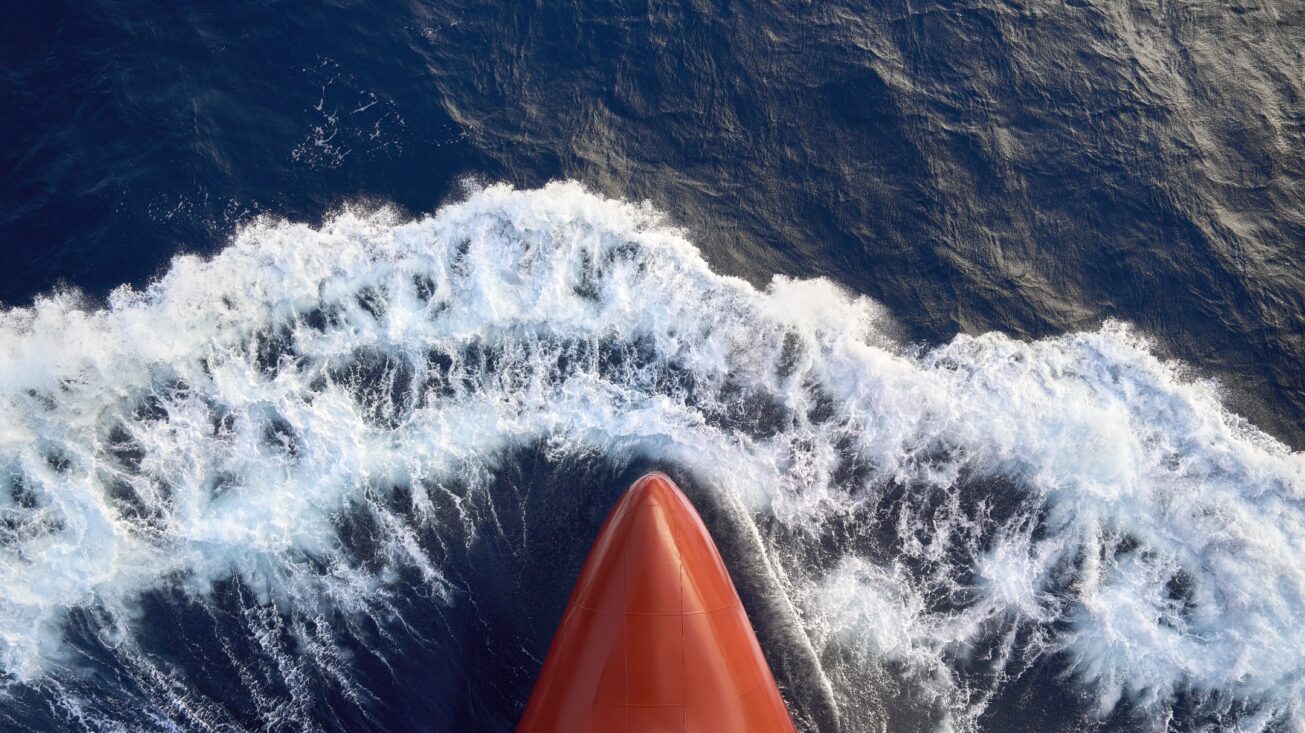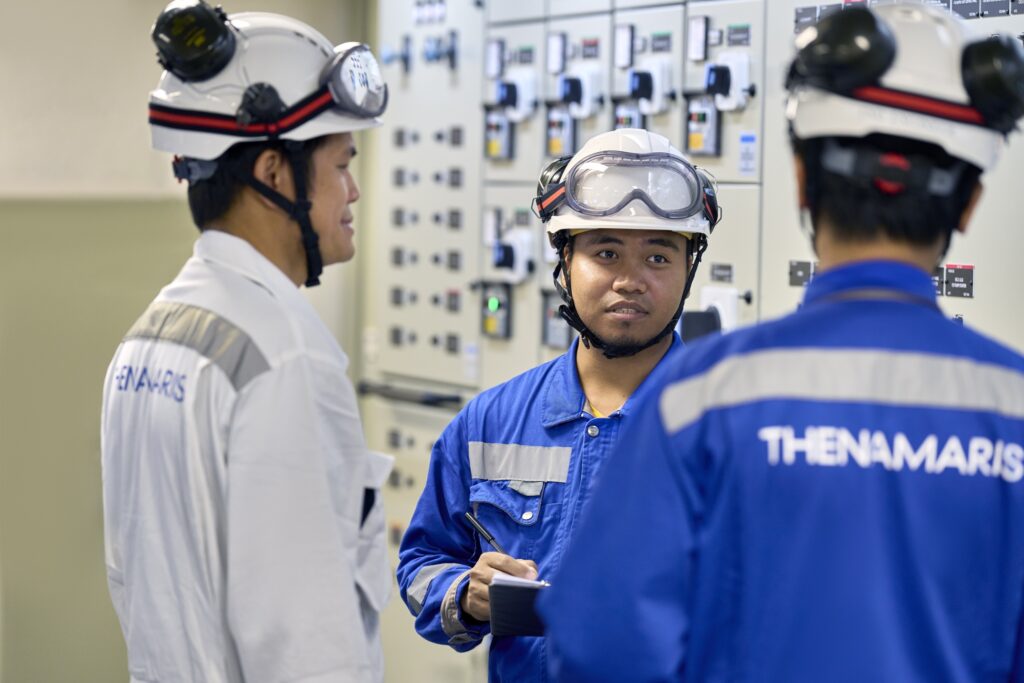This website uses cookies so that we can provide you with the best user experience possible. Cookie information is stored in your browser and performs functions such as recognising you when you return to our website and helping our team to understand which sections of the website you find most interesting and useful.
Leading the way in fuel consumption efficiency.

With highly volatile fuel prices, tighter regulations and increasing environmental concerns, fuel consumption efficiency is a high priority for charterers, as well as for ship operators.
In 2010 Thenamaris took the lead in the ship management industry by installing a pioneering technology, the Becker Mewis Duct® energy-saving device, and was an early adopter of the ‘slow steaming’ practice. Together, these two approaches resulted in dramatically increased fuel efficiency per transport work for the company in the coming years.
Scanning the horizon for the latest technologies
Vasilis Lampropoulos, Thenamaris’ Chief Operating Officer, explains why the company is committed to exploring new technologies that deliver measurable environmental benefits.
“Protecting and preserving the environment is deeply rooted in our business culture,” he says. “We aim to stay several steps ahead of the regulations and constantly scan the horizon for new technologies that can help us minimize our carbon footprint and maximize our environmental performance.”
The Becker Mewis Duct®: reducing fuel consumption by 3-5%
Thenamaris was the first ship management company to install a new fuel-saving technology on a vessel as large as a Suezmax tanker. The high-tech energy-saving device, the Becker Mewis Duct®, created by Becker Marine Systems, is a pre-swirl propeller duct specifically designed for each vessel, and reduces fuel consumption by approximately 3-5% on each vessel, resulting in the same level of CO2 emissions reduction.
Thenamaris has retrofitted this innovative technology on 31 vessels since 2010, and also explored alternative solutions and installed the Mewis Duct or other similar performing devices in newly built and recently delivered vessels since then.
A unique power-saving system
As explained by the sales team at Becker: “For vessels such as tankers or bulk carriers, the water flow to the propeller is unequal. As a result, the vessel consumes more fuel and creates more CO2 emissions. We designed the Becker Mewis Duct® to solve this problem and to generate a pre-swirl to improve the propeller efficiency. It combines two existing technologies – a duct and fins – to create a unique power-saving solution.”
The Becker Mewis Duct® system either provides significant fuel savings at a given speed or allows the vessel to travel faster at a specific power level. In both cases, the system results in reduced fuel consumption as well as fewer greenhouse gases.
A progressive partnership
When Becker developed the Becker Mewis Duct® system, the company immediately identified Thenamaris as a potential partner to adopt the new technology.
Thenamaris is interested in the latest technologies and open to new ideas, and quickly picked up on the suggestion from Becker. “We recognized that this was a sophisticated well-designed system that was pushing the boundaries of energy-saving technology,” says Minas Giaouzis, Technical Manager at Thenamaris.
A world first for the new system
Thenamaris decided to pilot the system on the SEADANCER, a Suezmax tanker. Thanks to good planning and teamwork, the installation went well and was completed successfully. The system’s power-saving ability was verified in trials and subsequent voyages, which encouraged Thenamaris to install the duct on further vessels. From January 2010 until 2015, installations gradually took place on both tankers and bulk carriers managed by Thenamaris.

The next generation of fuel-saving vessels
According to the team at Becker, “Thenamaris has invested in systems which enable them to measure the power output and fuel consumption of their vessels in considerable detail. They will have very clear measures of the efficiency of their fleet and can monitor changes over time. Thenamaris also gave us feedback about possible improvements to the Becker Mewis Duct® system, and we have no doubt that the company will be open to hearing about new ideas for the next generation of vessels.”
An early adopter of the slow steaming practice
During the past years Thenamaris has undertaken numerous initiatives to improve vessels’ performance, such as more frequent hull and propeller cleaning and the application of Variable Frequency Drives technology on electric motors. However, ‘slow steaming’ has so far proved the single most important method to reduce the fuel consumption and CO2 emissions.
“Slow steaming is a very effective way of reducing fuel consumption by cutting a vessel’s speed from a typical 15 to 16 knots for a tanker to a range of between 10 and 11 knots and sometimes even lower,” says Vasilis. “Although operating a ship at lower speed clearly saves on fuel consumption, the effect this could have on the main engine was unclear, so this approach had to be planned and managed carefully. Collaborating with the main engine makers was pivotal in building confidence for our initial trials.”
Slow steaming became common practice in the ship management industry after the global financial crisis hit in 2009. The main driving factors were the need to reduce CO2 emissions, cut costs and safeguard profitability by saving fuel. Thenamaris was ahead of the game as it started exploring much lower speeds in 2007, when the market was still strong and many ship management operators were reluctant to try out new methods.
“We first experimented with slow steaming when we realized that vessels were sometimes reaching their loading destination earlier than the contractual date,” says Vasilis. “This encouraged us to test new lower speed limits. The Technical department then designed a special program for the whole managed fleet to reduce the minimum acceptable Revolutions Per Minute (RPM) of the vessels’ engines for continuous operation.”
A significant reduction in CO2 emissions
So far, Thenamaris has taken advantage of more than 95% of slow steaming opportunities since 2015, and reduced fuel consumption by approximately 20%. Each reduction of one ton of heavy fuel oil results in a reduction of approximately 3.2 tons of CO2, which amounts to a significant reduction in CO2 emissions.
“If we hadn’t started our slow steaming trials early in 2007, Thenamaris would neither have been as ready nor as confident when the need arose to pursue slow steaming during the market downturn,” says Vasilis. “Slow steaming has helped us control our operating costs and support our financial sustainability.”
Slow steaming enabled Thenamaris to reap benefits across the company. The environmental footprint improved substantially through reductions in CO2, NOx and SOx. The Technical department was in a better position to optimize vessels’ performance and improve relevant Key Performance Indicators. The Operations department could maximize voyage results, and the Chartering department offered more competitive rates to charterers.
Staying ahead of the curve
By adopting the Becker Mewis Duct® system along with other propulsion efficiency improvement devices and slow steaming, Thenamaris successfully improved its competitiveness while minimizing its environmental footprint.
Vasilis comments: “There are always opportunities to improve performance, especially if you collaborate with others and are willing to explore new methods even before the need arises. Thenamaris will continue to explore new environmental initiatives to ensure that we can stay ahead of the curve, make a real difference to energy consumption, and help preserve our environment for future generations.”






